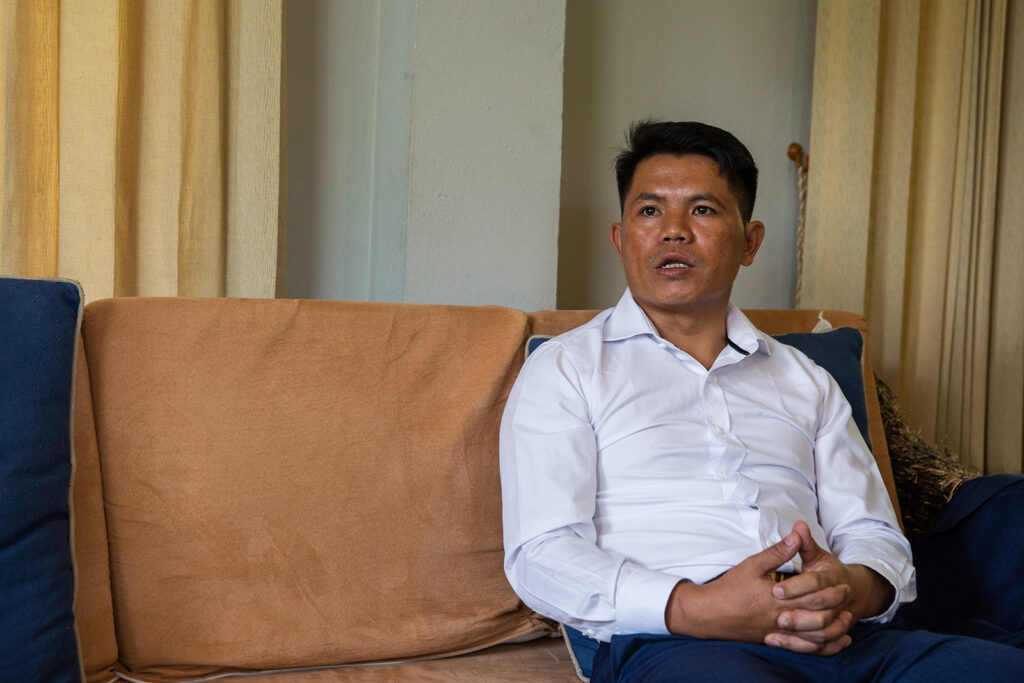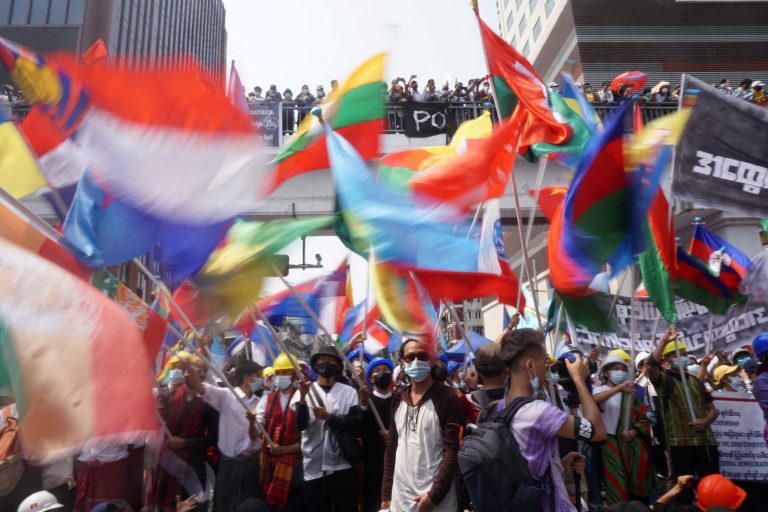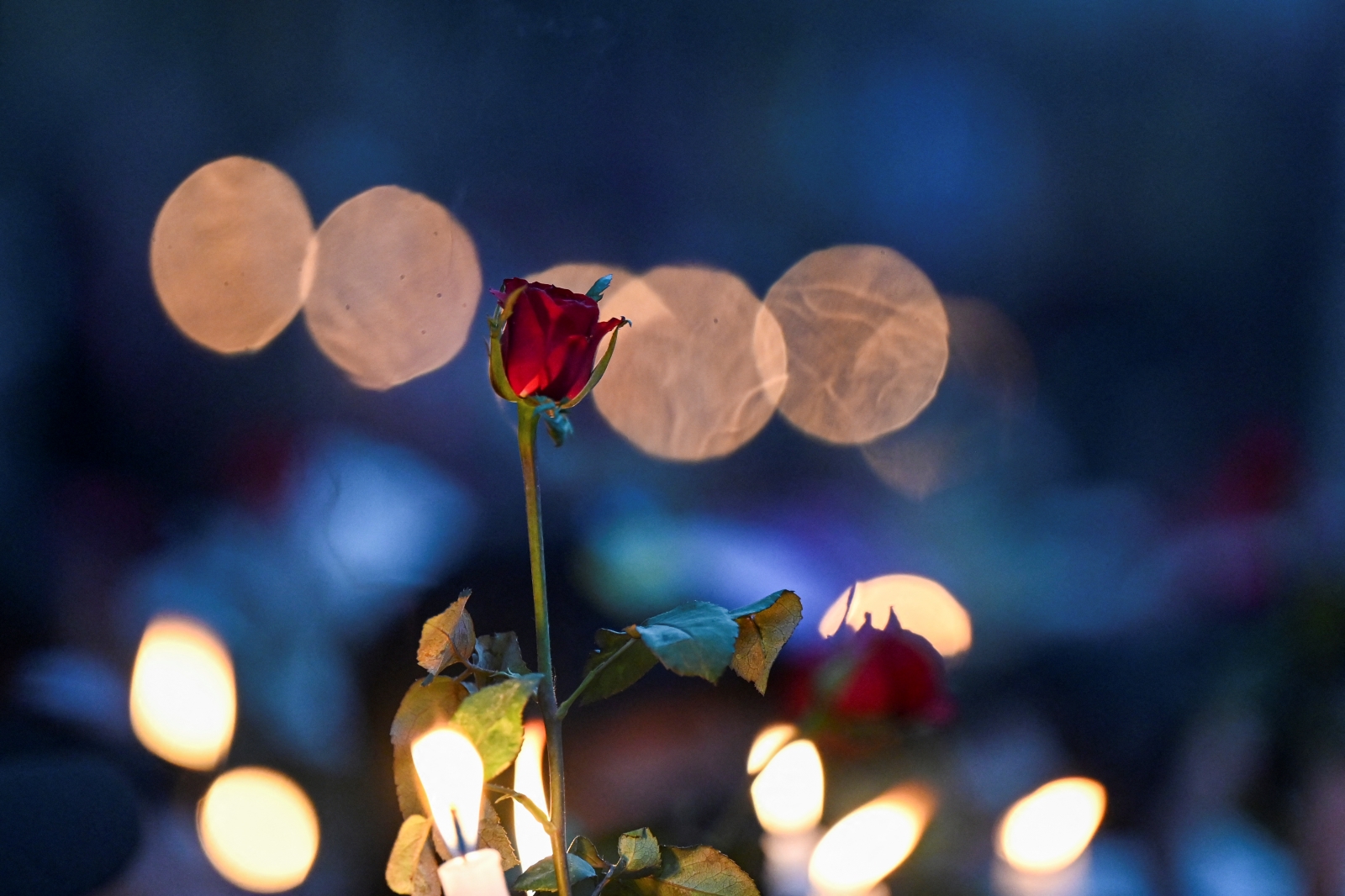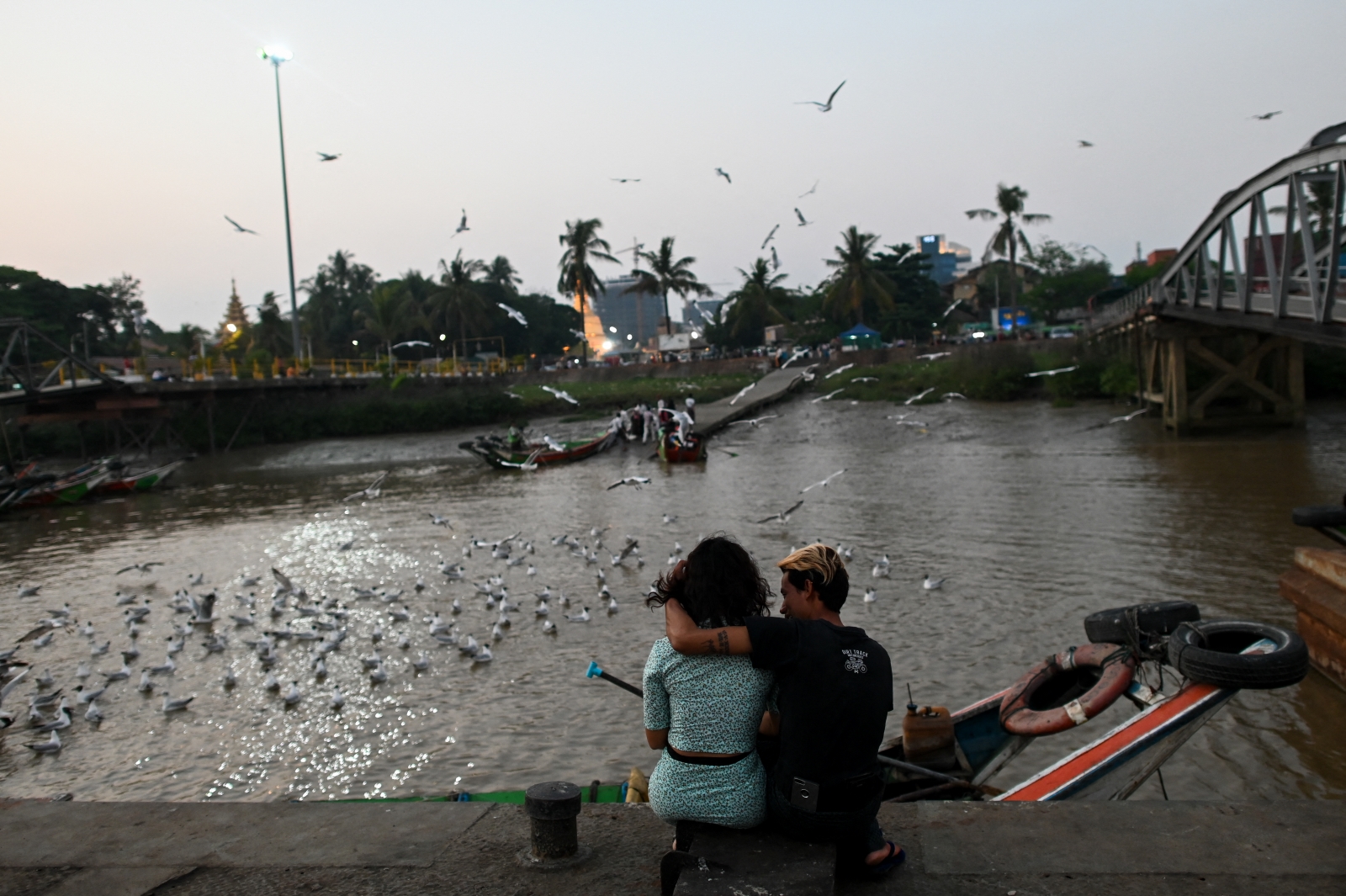The KNDF chair talks to Frontier about withstanding air strikes, unifying Karenni forces and building a parallel state government in one of Myanmar’s main conflict theatres.
By FRONTIER
On August 31, Frontier sat down with Khun Bedu, chairman of the Karenni Nationalities Defence Force, one of the most prominent armed resistance groups formed in response to the 2021 military coup. He discussed the state of the conflict, cooperation with other resistance groups and the massive humanitarian crisis. As vice-chair of the newly formed Interim Executive Council of Karenni State, he also described the council’s efforts to roll out public services.
This interview has been edited for length and clarity. It uses the term Karenni State, as preferred by many residents, for the territory also known as Kayah State.
Resistance forces seized Mese town near the Thai border in June. What is the situation there? Is the resistance still in control, and if so, what does that control look like? Are there still civilians in the town? Is the military using air strikes and artillery to try to take it back?
After we took Mese they were very upset, so they sent more troops, I think around 1,000 troops from Shan State and they pulled out some troops from Arakan [Rakhine] too. They sent some troops to Bawlakhe [north of Mese] by helicopter and started to attack us at the end of June. So, it’s already been two months of the State Administrative Council’s offensive against us to retake Mese.
There are around 400 SAC troops on the ground right now that have already crossed the [Thanlwin] bridge from Hpasawng [west of Mese] and penetrated around 15-20 miles into Mese Township. They are also shooting artillery from Bawlakhe and using air strikes. This is just the initial attack on Mese; the rest of the troops are still on the way. They’re coming by 120 trucks that left from Taunggyi [in southern Shan State]. They have arrived in Demoso already and are on their way [south] to Hpruso. Between Demoso and Hpruso is about 15 miles, and we control the main road, so we’re trying to attack them and stop them on the way.
The people have been evacuated since June; most of them fled to Thailand and are still staying there. Around 7,000 people are displaced – 4,000 in Thailand and the rest in Karenni National Progressive Party areas near the border.
Mese is like a skeletal war zone.
How do you defend yourself against the military’s artillery and air strikes?
The artillery is very heavy in Demoso especially, because the military’s supply is better there. They shoot a lot into areas where internally displaced people live, every day. They also did air strikes this morning – one killed some civilians and injured some civilians; we don’t know how many yet.
We have bunkers, but on the front line there is no way you can prepare for it, you just have to face it. Most of our deaths and injuries are because of artillery and air strikes. They target civilians but also the front lines.
Usually, the military achieves its objective when they do a lot of air and artillery strikes. They are able to move forward step by step and reach where they are going. We cannot stop them, but we do have a limited amount of our own artillery and mortars.
We were able to confiscate a lot of weapons during fighting in June, including six 120mm mortars, which are very advanced, very heavy and very effective. But they’re limited so we have to choose a strategic time and place. It’s incomparable to their supply.
In June, the Karenni National People’s Liberation Front militia defected from military command, joining the resistance. What role is the KNPLF now playing in the broader resistance? Is everyone cooperating well or are there some lingering challenges in integrating them?
We can reveal that the KNPLF was involved in the revolution from the beginning. They trained many young people, including some of the battalions of the KNDF. They were also involved in the fight on the front lines, without using their badges and uniforms, and some of them died.
It’s still very significant that they officially changed, and it has had a big impact on the military. Some SAC troops were forced to abandon their positions and run away. The involvement of the KNPLF in the revolution also creates unity; we are now moving in one direction.
We now consult, plan and do the resistance together. They need some time to prepare and settle, so they are still in that process. Hopefully they will be part of the IEC [Interim Executive Council of Karenni State]. We are also forming a state army, to have all of the different armed groups in Karenni registered as state troops under the state government. We will put all of our resources together, and unlike the corrupt military junta, we will be under civilian control to serve the people. Hopefully the KNPLF will make up their mind and join us.

There are many other armed groups operating in Karenni State. The KNPP’s armed wing, the Karenni Army, has been fighting for political autonomy for decades. The People’s Defence Forces were formed after the coup, and are loyal to the National Unity Government, which was appointed by deposed lawmakers. There also seems to be increased cooperation with the Karen National Union, another ethnic armed group that fights for autonomy for the Karen people. What is the KNDF’s relationship with these various groups?
The KNDF was set up very independently, but as we prepared to fight the military, we asked the ethnic armed organisations to be our commanders and share their resources with us, so they did. The KNDF is under the command of the Karenni Army.
There are PDFs that are directly under the chain of command of the NUG. These groups are based locally but are loyal to the NUG, which is fine, but since they are fighting in Karenni State they have to coordinate with different groups like the KNDF.
We had some issues in the beginning but now it has been totally resolved. The KA, KNDF and PDF coordinate together for military operations and even share supplies. But the ideology is slightly different. All the Karenni groups will be under the state government, and the PDFs will remain under the NUG and will be registered under the union government.
We have fought together with the KA, KNPLF and KNU since some time ago. The KNU has deeper skills and experience than most of the Karenni troops. All the Karenni groups trust the KNU, and when the KNU is involved in an operation, we are happier and more confident. The coordination with the KNU is more related to military and defence, not political. We work together on specific missions, but for most of the fighting, we are on our own. So far we haven’t gone to any Karen areas to support them.
This is not only a fight against the military junta, but also a fight to create unity among our ethnic people and people of different backgrounds.
The Interim Executive Council was formed in June to serve as the parallel government of Karenni State. What is the purpose and structure of the IEC?
In the beginning, the NUG tried to set up their administration and there were also EAO administrations – especially the KNPLF and the KNPP. Different groups were doing different things and there was no political consensus or greater administration. So we had a conference and came up with this interim arrangement involving the Karenni State Consultative Council, IEC and [state] parliament.
Under the KSCC [which was founded shortly after the coup] we have a judicial body, with five township courts and an appeal court. This month, we put a prison under the judicial body. We also have nine police stations. In the past, we detained people at the police stations, but they’re too crowded and not good, so now we have more space with the prison.
We recently started to recall the elected members of parliament to serve in the Committee Representing Karenni State Hluttaw – people from the National League for Democracy and the Kayah State Democratic Party are now working in this state hluttaw. Their role will be to make laws and review policy.
The IEC is more like the executive branch, but instead of one prime minister we have seven political leaders who collectively fill the role of a prime minister. The IEC has 12 departments, and as of this week, we have been able to declare five operational areas. Each department has four leaders and includes representatives from armed groups, [striking civil servants in] the Civil Disobedience Movement, members of parliament and activists.
For example, in the health department, we have one representative from an armed group and three from the CDM. For education, we have one person from an armed group, one MP and two CDM.
What public services is IEC providing on the ground?
We are trying to support 3,500 teachers with a stipend and send school materials to 40,000 children across 400 schools. We also run 90 clinics and eight hospitals. We are targeting about US$20 million for the annual budget, but we haven’t yet reached that.
The services are not 100 percent run by the IEC – our role is to coordinate, find support and raise and allocate funds. Many of these things were started by different groups. The Civil Health and Development Network provided healthcare since before the coup, the KNPP had its own services and now we have CDM workers. Our job is to coordinate with them, help them and restructure public services under the IEC.
In the beginning, we tried to use the previous government buildings, but SAC knew where they were, so they bombed them. They bombed five hospitals. They would even bomb schools. So we had to relocate. Most of our public buildings are now underground, very secret, and safer. There are bomb shelters in all of them.
Does the IEC see itself as the state government and the NUG as the union government? Do you see the IEC as being under the NUG?
We coordinate with the NUG a lot. One thing we still have to clarify is power sharing between the NUG and the IEC, although it’s already getting clearer. Instead of the NUG imposing their administration in Karenni State, they share their budget with the IEC and the IEC implements projects effectively. We have a good mechanism so far.
This is the beginning of federalism in Burma. We don’t need to have a settled constitution or a clear power-sharing agreement yet. I think the NUG is also happy with the current arrangement. We are both fighting against the military regime. There’s no need for us to discuss in too much detail for now.
Karenni resistance forces have seen a lot of military success since the coup, but there also seems to be a massive humanitarian crisis. Is that one of the biggest challenges you face right now, and can that be overcome?
The main challenge for us is the killing of innocent people by the SAC. Whenever they do offensives, they always burn down villages, churches and houses and shoot people. Recently in Moebye [in southern Shan near the border with Karenni], they killed about 20 civilians and we could only recover five or six bodies.
The people have to flee all the time. They face economic hardship, food shortages and a lack of healthcare and education. They always ask us, “when can we go back to our homes?”
It’s a great challenge for the IEC. We need to help the people as much as we can and empower them to return to farming and other livelihoods. Our intention is to show the people why we are fighting. The needs of the people and the needs of the revolution go together. If we can support the people, they can continue to be resilient, and our revolution can win.
We have managed to contain the SAC in urban areas, but this results in the destruction of towns. Mese, Bawlakhe, Hpruso, Demoso – all of these urban areas are totally burned down, covered in landmines, destroyed by artillery and air strikes. The SAC can now only govern in [the state capital] Loikaw. We could choose to fight in Loikaw but that would be another city devastated.
We can’t yet call the revolution a success, but our resistance fighters are growing and becoming more experienced. We have better access to weapons and ammunition now, so there’s no way we will collapse easily. We will continue to grow and become more sustainable.
We are determined to restore the people’s government, and not to live under a brutal military government.







